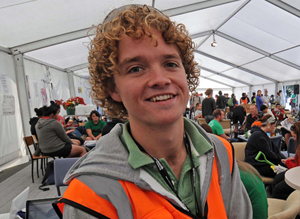Login | Subscribe | Stay Engaged | About | Partnerships | Contact
Students
The Role of Volunteer Resource Managers in Fostering the Next Generation of Nonprofit Leaders

High school students do not often think of nonprofits as an option for career-building. Although they may have been exposed to nonprofits through volunteering or community service requirements, they are generally guided by career counselors and their parents to have career aspirations outside of the nonprofit sector.
In this issue of Research to Practice, Laurie Mook looks at a mixed-method study of nonprofit professionals from various chapters of the Young Nonprofit Professional Network and explores how students initially became aware of nonprofit careers and the connection between volunteering and career selection. The implications for volunteer resource managers and their role in fostering the next generation of nonprofit leaders are discussed. The conclusion? At a time when the need for nonprofit leadership continues to grow, volunteer resource managers can play an important role in nonprofit career decision-making for students.
Teen Volunteers Impact a Hospital's Electronic Medical Records Initiative

Imagine teen volunteers in a healthcare setting. Admit it: Your first impression probably centered on teenagers pushing carts, delivering flowers or books, or escorting therapy dogs to patients’ rooms. But in the Medical Center Health System in Odessa, Texas, teenagers did more than push carts – they pushed the proverbial teen volunteer envelope to help develop an Electronic Medical Record (EMR) or Electronic Health Record (EHR) volunteer interdisciplinary team within the health care system.
In this feature story, Patricia Q. Garcia, Director of Volunteer Services and Community Relations Coordinator at the health system, highlights how teens became involved in developing the EMR and EHR systems. She explains the benefits derived from this youth volunteer initiative, and why the administration supported this volunteer-driven program. According to Garcia, this initiative was not only a success, “it serves as a best practice for future volunteer-led programs.” And it helps illustrate how to engage, value, and retain tomorrow’s leaders by working with teen volunteers.
Considerations for Volunteer Resource Managers In Engaging Service-Learners
 The debate continues over whether or not students in service-learning placements should be considered volunteers, and this type of unpaid labor often falls under the purview of a volunteer resource manager. Indeed, engaging service-learners is one strategy that can be used to extend the work of an organization.
The debate continues over whether or not students in service-learning placements should be considered volunteers, and this type of unpaid labor often falls under the purview of a volunteer resource manager. Indeed, engaging service-learners is one strategy that can be used to extend the work of an organization.
There are many studies about the impact of service-learning from the perspective of the student and the campus. This quarter’s Research to Practice looks at one of the few studies that analyzes the impact of service-learning on the community partner. This study, “Service-learning from the supply side: Community capacity to engage students” (Littlepage, Gazley & Bennett, 2012), is based on a sample of over 1,000 nonprofit and religious organizations in two counties in Indiana. It provides important insights for volunteer resource managers who are considering or already engaging service-learners.
Students vs. The Machine: Lessons Learned in the Student Community Following the Christchurch Earthquakes
 When massive earthquakes hit Christchurch, New Zealand in February 2011, university students wanted to help in the clean-up. But established first response agencies were wary of these young volunteers and too harried to work with them, so they turned them away. Sam Johnson, a student leader, would not take "no" for an answer. He turned to Facebook and put out a call to his friends. Within hours, Johnson had recruited a team of workers and borrowed enough loaned equipment to go out and simply start “mucking out.” Over the next several days, as his social network spread the word, hundreds and then thousands of students stepped forward. They called themselves the Student Volunteer Army (SVA) and eventually numbered 9,000 volunteers, earning the respect and support of the local authorities along the way. The story of Johnson and the Student Volunteer Army eventually drew headlines around the world, and attracted the attention and praise of everyone from Prince William of England to Secretary of State Hillary Clinton of the United States. Because of the media attention SVA received, the student volunteers were invited to Japan after the tsunami hit to work with a like-minded team of students. And Johnson recently returned from the World Summit for Youth Volunteering in Colombia, South America, where he presented on the role of Youth in Disaster.
When massive earthquakes hit Christchurch, New Zealand in February 2011, university students wanted to help in the clean-up. But established first response agencies were wary of these young volunteers and too harried to work with them, so they turned them away. Sam Johnson, a student leader, would not take "no" for an answer. He turned to Facebook and put out a call to his friends. Within hours, Johnson had recruited a team of workers and borrowed enough loaned equipment to go out and simply start “mucking out.” Over the next several days, as his social network spread the word, hundreds and then thousands of students stepped forward. They called themselves the Student Volunteer Army (SVA) and eventually numbered 9,000 volunteers, earning the respect and support of the local authorities along the way. The story of Johnson and the Student Volunteer Army eventually drew headlines around the world, and attracted the attention and praise of everyone from Prince William of England to Secretary of State Hillary Clinton of the United States. Because of the media attention SVA received, the student volunteers were invited to Japan after the tsunami hit to work with a like-minded team of students. And Johnson recently returned from the World Summit for Youth Volunteering in Colombia, South America, where he presented on the role of Youth in Disaster.
Today, SVA continues its work as the Christchurch area experiences aftershocks and further quakes. In this e-Volunteerism feature, Johnson shares what it’s like to be at the center of the growing emergency response momentum. He allows that he instantly had to learn volunteer management skills, describes how he successfully used social media tools, and reviews how others can connect to young people through online networks. And he explains his strong vision for “the positive change that can occur if technology at our fingertips is harnessed by Generation Y to build stronger community relationships.”
Effective Youth Engagement in Generation Y: Lessons from the Field
Despite all the theory and research about Generation Y — those individuals typically born between 1977 and 1997 — there still appears to be a considerable amount of confusion as to how volunteer managers can effectively engage this generation. Could this confusion stem from not clearly understanding the key factors that shape the lives and thinking of Gen Y? Author Catherine Williams thinks so. In this feature article, Williams reviews how effective engagement with today’s young adults involves moving beyond the hype associated with this generation and developing a deeper understanding of what shapes the lives of our younger generations. By sharing the stories of a few Gen Y individuals (also called Millennials), Williams presents some important lessons about why young people are not engaging in traditional volunteer roles. She also looks at the implications for volunteer management practices, and explores some of the changes that volunteer managers may need to consider in order to make volunteering relevant to this generation.
Young People's Volunteering and Skills Development
In a recent report, The National Youth Agency in England explores the skills, knowledge and attitudinal development that young people derive from volunteering. The research did not intend to evaluate volunteering projects in terms of quality or volunteer management. Rather, the study focused on how youth benefited from volunteering, and what mattered most to them during the volunteer process. The researchers explored this issue in depth through 30 case studies and interviews with 215 young people. This Research to Practice reviews the key themes of this report, suggests how organizations can use the findings to promote the message of volunteering to the young, and discusses how the results can benefit and enhance the volunteering experiences for volunteers of all ages.
